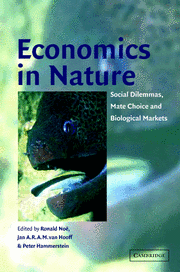Book contents
- Frontmatter
- Contents
- List of contributors
- Preface
- Acknowledgments
- 1 Games and markets: economic behaviour in humans and other animals
- Part I Economic behaviour in social networks
- Part II Biological markets
- Part III Mating markets
- 9 Human mate choice strategies
- 10 How does mate choice contribute to exaggeration and diversity in sexual characters?
- 11 Information about sperm competition and the economics of sperm allocation
- 12 The economics of male mating strategies
- Index
9 - Human mate choice strategies
Published online by Cambridge University Press: 04 August 2010
- Frontmatter
- Contents
- List of contributors
- Preface
- Acknowledgments
- 1 Games and markets: economic behaviour in humans and other animals
- Part I Economic behaviour in social networks
- Part II Biological markets
- Part III Mating markets
- 9 Human mate choice strategies
- 10 How does mate choice contribute to exaggeration and diversity in sexual characters?
- 11 Information about sperm competition and the economics of sperm allocation
- 12 The economics of male mating strategies
- Index
Summary
Introduction
In many species, the process of mate finding begins with advertising. As such, advertising is an opening bid that is often made in the absence of any information about the quality (and sometimes even the identity) of potential mates. These bids will, however, often reflect a trade-off between the individual's assessment of its own preferences and its experience of what the marketplace in general has to offer. This is as true of human beings as it is of other species (Grammer 1989). In humans, bids of this kind are often contingent on the advertiser's perception of his/her own bargaining hand; in consequence, the level of demands that an advertiser makes may vary according to what he/she has to offer (Waynforth & Dunbar 1995).
Advertisements in personal columns provide one outlet where human mate choice criteria are explicitly elaborated. Analyses of the content of such advertisements have consistently shown that the words used in these advertisements reflect a small number of key dimensions that have strong evolutionary valency (Kenrick & Keefe 1992; Wiederman 1993; Greenlees & McGrew 1994; Waynforth & Dunbar 1995; Bereczkei et al. 1997). All these studies concur that the single most important criteria by which men assess the mate quality of women is age (or, as a surrogate of this, physical attractiveness), while women tend to emphasise a wider range of criteria, including wealth/status and commitment (Borgerhof Mulder 1988a; Buss 1989; Voland & Engel 1990; Kenrick & Keefe 1992; Waynforth & Dunbar 1995; for a review of the more general literature, see Grammer 1989). Age in women is significant because it is a direct correlate of both fertility and future reproductive potential (Fisher's reproductive value).
- Type
- Chapter
- Information
- Economics in NatureSocial Dilemmas, Mate Choice and Biological Markets, pp. 187 - 202Publisher: Cambridge University PressPrint publication year: 2001
- 5
- Cited by



